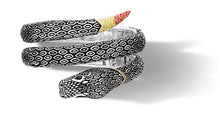Snake motifs are one of the earliest historical and culturally diverse mythological symbols, and figure prominently in jewelry. These intriguing creatures and the alluring pieces inspired by serpents through the ages, from the fall of Adam and Eve in the Garden of Eden, represent a host of meanings in different countries and civilizations.
To the pharaohs of Egypt, snakes represented royalty and deity and they wore them as sacred pendants around their necks. The Romans had different interpretations ranging from everlasting love to a symbol of wisdom. The Greeks also looked toward the serpent as a symbol of wisdom, and to Aesculapius, the god of medicine, who had a snake wrapped around his staff - a motif that continues to remain the symbol of the medical profession. The Hindus, Hebrews, and African and Native Americans have all endowed the slinky creature with various meanings, ranging from rebirth, transformations, sexuality and desire.
And speaking of desire, Cleopatra might be well known for her head-to-toe accessorizing in snake jewels but it was in 1839 that lore and legend made way for the snake to become one of the most iconic motifs in jewelry. This was when Queen Victoria was engaged to Prince Albert and received a continuous snake ring, which signified everlasting love for eternity, with an emerald, her birthstone, centered in its head. Queen Victoria’s ring set a trend throughout England, and eventually throughout Europe, for a range of snake rings, coil-style flexible necklaces and bracelets with gem-set heads, as well snake brooches, cuffs, bangles, and hoop and drop earrings that featured a snake slinking around a gemstone.
We have invested over one year in developing this One-of-Kind Serpyntine Coiled Bracelet in Silver and 14K Gold with multi-color pave' sapphires.




